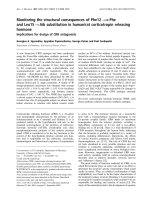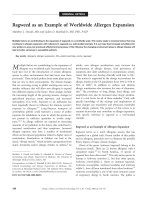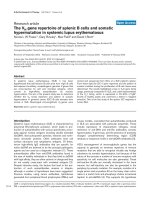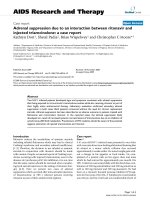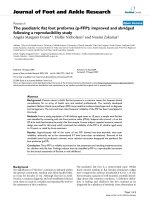Báo cáo y học: " Coagulopathy as initial manifestation of concomitant celiac disease and cystic fibrosis: a case report" pot
Bạn đang xem bản rút gọn của tài liệu. Xem và tải ngay bản đầy đủ của tài liệu tại đây (275.8 KB, 4 trang )
CAS E RE P O R T Open Access
Coagulopathy as initial manifestation of
concomitant celiac disease and cystic fibrosis:
a case report
Aco Kostovski
*
, Nikolina Zdraveska
Abstract
Introduction: Celiac disease and cystic fibrosis have many common manifestations, such as malabsorption,
steatorrhea and growth failure, and were for many years recognized as one clinical entity. Since their recognition
as two separate diseases, their co-existence in a patient has been described sporadically; around 20 cases have
been descr ibed in the literature. Taking into consideration the incidences of the two diseases, the chance of them
occurring together is one in 2,000,000 in the general population.
Case presentation: We describe the case of a five-year-old boy of Turkish ethnicity with both celiac disease and
cystic fibrosis, who presented initially with a skin hemorrhage. The diagnosis of celiac disease was made with a
positive serum anti-tissue transglutaminase antibody test and the presence of HLA-DQ2 heterodimer, and
confirmed on histology with small intestinal villous atrophy. A positive sweat test confirmed the diagnosis of
associated cystic fibrosis.
To the best of our knowledge there has been no previous report of this rare presentation of associated celiac
disease and cystic fibrosis.
Conclusion: The clinical significance of this case is the consideration of malabsorption with both celiac disease
and cystic fibrosis in patients who present with unexplained coagulopathy.
Introduction
Celiac disease (CD) is a multi-factorial, autoimmune dis-
order that occurs in genetically susceptible individuals,
triggered by a well-identified environmental factor–
gluten. Originally considered to be a rare malabsorption
syndrome of childhood, CD is now recognized as a
common condition that may be diagnosed at any age
and that affects many organ systems. The interplay
between genes and the environment leads to the onset
of intestinal and/or extraintestinal symptoms.
Cystic fibrosis (CF) is the most common genetically
inherited disease in Caucasian populations. Understand-
ing of the disease has progressed rapidly the past
20 years. CF used to be predomi nantly a lung disease of
young children but more recently it has become a com-
plex multi-system disease extending into adu lthood. The
co-existence of CD and CF was first described, in a
child, by Hide and Burman in 1969 [1], and around 20
cases have been reported in the literature.
We present the case of a boy with concomitant CD
and CF, initially manifesting with a skin hemorrhage. To
the best of our knowledge there has been no previous
report of this rare hemorrhagic presentation o f conco-
mitant CD and CF.
Case report
A five-year-old boy of Turkish ethnicity was referred to
our hospital because of the spontaneous appearance of
hematomas on both his upper and lower limbs and on
his back over the preceding few weeks. His parents were
healthy, unrelated, and he had no siblings. No family
history for genetic diseases was reported. He was born
out of normal pregnancy and delivery, with a birth
weight of 4.1 kg; had normal peri-natal course and regu-
lar weight gain. He was bare ly breastfed and cow’smilk
was introduced from his first month. There were no
previous hospital admissions. He did not have any major
* Correspondence:
University Children’s Hospital, Department for Gastroenterology and
Hepatology, Skopje, Former Yugoslav Republic of Macedonia
Kostovski and Zdraveska Journal of Medical Case Reports 2011, 5:116
/>JOURNAL OF MEDICAL
CASE REPORTS
© 2011 Kostovski and Zdraveska; licensee BioMed Central Ltd. This is an Open Access article distributed under the terms of the
Creative Commons Attribution License ( nses/by/2.0), which permits unrestricted use, distribution, and
reproduction in any medium, provided the original work is properly cited.
illnesses except for a few upper respiratory infections
which were successful ly treated with medication. In
addition to these, he had experienced occasional, mild,
non-troublesome cough that had never required treat-
ment. His abdomen was always distended and his
mother reported three to four l oose stools per day in
the last five months.
A general physical examination on admission revealed
skin paleness, but no jaundice, and remarkable multiple
bruises on both his legs and right arm and a single large
hematoma in the lumbar region of his back. An exami-
nation of his abdomen showed marked abdominal dis-
tension, with no hepatosplenomegaly and no palpable
mass or ascites. His height was on the third percentile,
his weight was within the 25
th
percentile for his age. His
body mass index was 16.5 (within the 50
th
percentile for
his age).
A laboratory analysis was suggestive of iro n deficiency
anemia, with hemoglobin level 97 g/L, serum iron
2.8 μmol/L, hypoproteinemia (50 g/L protein), hypoal-
buminemia ( 23 g/L albumin), elevated serum aspartate
transaminase (AST) (129 U/L), and elevated alanine
transam inase (ALT) (159 U/L). A coagulation screening
profile showed normal platelets number and bleeding
time, but a prolonged prothrombin time (PT) of 63s
(normal range 12 to 15s), and prolonged activated par-
tial thromboplastin time (aPTT) of 105s (normal 34s).
Possible primary liver disea se was excluded, with nega-
tive antibodies for viral hepatitis A, B and C, as well as
negative antibodies for autoimmune hepatitis type I and
II. Cerulo plasmin and a1-antitrypsin were w ithin nor-
mal limits for his age. A liver biopsy was not performed
because of the severe coagulation impairment. A rapid
screening test for tissue transglutaminase IgA antibodies
was positive, with quantitative measurements o f
903.3IU/mL (normal range 20IU/mL). Antigliadin IgA
was 1822IU/mL (normal range < 25IU/mL) and antiglia-
din IgG was 922.6IU/mL (normal range <25IU/mL).
Histologic assessment of the intestine revealed villous
atrophy, cryptal elongation and hyperplasia plus
increased intra-epithelial lymphocytes and mononuclear
cells infiltration into the lamina propria. HLA typing
was positive for HLA-DQ2 (DQB1*02 homozygous). A
sweat test was preformed on two separate occasions and
came back positive, with chloride concentration measur-
ing 118 mmo l/L and 6 7 mmol/L. A chest radiogra phy
showed hyperinflation with increased retrosternal air
space and reduced transparency in his lower lung lobes,
especially expressed on the right side. The molecular
work up was nega tive for the m ost frequent mutations
of cystic fibrosis transmembrane conductance regulator
(CFTR) (only 11 are available in our center). Our patient
was diagnosed to have both CD and CF. Treatment with
ursodeoxycholic acid and pancreatic enzymes, antibiotics
and oral iron supplementation was initiated and a
gluten-free diet was recommended.
During the hospital stay plasma transfusion and Vita-
min K substitution was administered to normalize the
coagulation tests, as well as albumin supplementation.
The PT and aPTT returned to normal values and
remained normal throughout the rest of his hospitaliza-
tion. Our patient was followed-up two months after the
treatment, during which he was on a gluten-free diet
and oral iron supplementation. The child looked healthy
and had gained weight; his stools became less frequent
with normal co nsistency. No recurrent bleeding or
hematomas were detected. His liver enzymes, serum
protein and albumin values were normal. Coagulation
tests were normal without additional vitamin K supple-
mentation. A sweat test was performed again, and was
positive with chloride concentration of 72 mmol/L.
Discussion
CD is an autoimmune inflammatory enteropathy that is
triggered by the ingestion of glut en-containing grains in
genetically susceptible individuals. CD is one of the
most common lifelong disorders on a worldwide basis,
affecting nearly 1% of the general population in the
USA and other developed countries [2]. Studies in the
last years have shown that the pre valence of CD h as
substantial increased [3]. The availability of sensitive
and specific serological tests has made it possible to
assessthetrueprevalenceofCDbydetectingthemini-
mally symptomatic or asymptomatic cases with typical
mucosal changes. Results from genetic linkage studies
have shown that CD is strongly associated with HLA-
DQ genes located on chromosome 6p21. Approximately
90-95% of patients with CD present DQ2 heterodimer
and most of the remaining cases carry HLA-DQ8 mole-
cules. The absence of these alleles is important for their
high negative predictive value [4,5].
The clinical spectrum of CD is wide, including cases
with either typical intestinal features or atypical extrain-
testinal features. Recently, attention has been focused on
the a typical presentations of CD, such as i solated ane-
mia, osteoporosis, sho rt stature, peripheral neuropathy,
rickets, constipation, or delayed puberty. Whilst these
presentations of CD have become more recognized,
hemorrhagic presentations of CD owing to coagulopathy
are quite rare. It ca n result from vitamin K deficiency
due to malabsorption or as a consequence of liver injury
[6].
Persistent elevation of serum aminotransferase activity
is the mo st common liver abnormality found in patients
with CD and may occur in up to 60% of cases. This is a
reversible gluten-related type of liver damage known as
celiac hepatitis [7]. Severe hepatic damage rarely occurs
in patients with CD. Casswall et al. reported six children
Kostovski and Zdraveska Journal of Medical Case Reports 2011, 5:116
/>Page 2 of 4
treated in their center with acute liver failure and coagu-
lopathy associated with CD over a 12 year period of
time. Two of them had t o receive liver transplants.
Thus, they suggested routinely checking for liver func-
tion in all children wit h new onset CD, and also investi-
gating for untreated CD in children with severe liver
damage [8].
CF is the most common autosomal recessive disease,
with a global incidence of 1 in 2500 newborns. The
gene responsible for this disease–CFTR–was identified
in 1989. The most common CFTR defect is the ΔF508
mutation, occurring in about 70% of patients with CF
[9]. Currently more than 1600 mutations in the CFTR
gene have been described. Different CFTR mutations
result in different disease phenotypes. Some may have
little or no effect on CFTR function and may result in
milder forms of disease. According to the generally
accepted criteria, diagnosis of CF requires one or more
characteri stic clinica l features in combi nation wit h
laboratory evidence of CFTR dysfunction (two elevated
sweat chloride concentrations obtained on separate
days) or identification of two p athologic CFTR muta-
tions [10].
Unlike pulmonary and pancreatic manifestations that
are present in 80-90% of CF patients, liver involvement
is much less frequent, affecting only one third of CF
patients [11]. Corrigan et al. in 1981 documented a coa-
gulopathy in 17 (71%) o f 24 patients with CF, mean age
17 yea rs. In three cases this was suggestive of liver dis-
ease, and in 14, of vitamin K deficiency [12]. In 1994
Durie assessed the need for routine vitamin K supple-
mentation in patients with CF [13]. Factors in CF that
predispose patients to vitamin K deficiency may include
malabsorption, cholestatic or non-cholestatic liver dis-
ease, and chronic antibiotic intake [14].
CD and CF share a number of clinical manifestations
and were for many years recognized as one clinical
entity [9]. Co-existence of the two diseases in the same
patient has been reported sporadically since the 1960s.
In 1999, Venuta et al. described a patient suffering from
CD and CF and reviewed the available lite rature, sum-
marizing 16 documented cases of CD co-existing with
CF [15]. Valletta and Mastella in 1989 described five CD
cases among 1100 CF patients and the incidence of CD
co-morbidity was calculated to be at least one in 220
(0.45%) [16]. Fluge et al. in 2009 performed a systematic
screening for CD in a large Scandinavian cohort of 790
CF patients, and detected 10 patents with CD (1.2%)
[17]. A recent study from Poland reported 2.13% inci-
dence of CD among 230 CF patients [18].
Taking into consideration the incidences of these two
diseases, the chance of their occurring together in the
general population is one in 2,000,000 [19].
Intheliteraturetherearesomehypothesestoexplain
the co-e xistence of CD and CF. Due to pancreatic in suf-
ficiency in patients with CF, the mucosa of the bowel
may have more contact with the complete gluten pro-
tein. In addition, malnutrition might contribute to some
additional mucosal damage [18]. Some studie s also sug-
gest increased incidence of food allergy in CF patients
[19].
In our case, the first challenge was to identify the
etiology of the bleeding diathesis. The abnormality o f
both the PT and PTT, as seen in our patient, led to th e
consider ation of a multiple coagulatio n factors abnorm-
ali ty. In such abnor malities the hepatic synthesis of fac-
tors II, VII, IX, and X from vitamin K is impaired. The
most common manifestations, bleeding from hypopro-
thrombinemia, are ecchymosis and hematomas, as seen
in our patient. Vitamin K malabsorption leading to
hemorrhage is an unusual presentation of both CD and
CF. The chronic diarrhea, that had not been diagnosed
until this episode, assisted in narrowing the diagnosis.
The positive serologic test in correlation with HLA-DQ2
presence was strongly suggestive for CD. Intestinal his-
tology and marked clinical improvement after gluten
withdrawal confirmed the diagnosis. Our patient also
fulfilled the diagnostic criteria for CF because of the
manifested pancreatic insufficiency and a chest radiogra-
phy, with the initial diagnosis confirmed with the posi-
tive sweat test.
Conclusion
The clinical significance of this case is in the considera-
tion CD and CF in patients who present with unex-
plained coagulopathy. The presence of abnormal tests of
coagulation should prompt the clinician to consider any
signs of malabsorption. The co-existence of CD and CF
in this case was also a motive to systematically screen
forCDamongotherCF-diagnosedpatientsinour
center.
Consent
Written informed consent was obtained from the
patient’s father for publication of this case report and
any accompanying images. A copy of the written con-
sent is available for review by the Editor-in-Chief of this
journal.
Authors’ contributions
AK analyzed and interpreted the patient data and performed the GI
endoscopy. NZ analyzed and compiled all the data and laboratory analysi s
and was the major contributor in writing the manuscript. All authors read
and approved the final manuscript.
Competing interests
The authors declare that they have no competing interests.
Kostovski and Zdraveska Journal of Medical Case Reports 2011, 5:116
/>Page 3 of 4
Received: 13 October 2010 Accepted: 24 March 2011
Published: 24 March 2011
References
1. Hide DW, Burman D: An infant with both cystic fibrosis and coeliac
disease. Arch Dis Child 1969, 44(236):533-535.
2. Rubio-Tapia A, Murray J: Celiac Disease. Curr Opin Gastroenterol 2010,
26(2):116-122.
3. Lohi S, Mustalahti K, Kaukinen K, Laurila K, Collin P, Rissanen H, Lohi O,
Bravi E, Gasparin M, Reunanen A, Mäki M: Increasing prevalence of coeliac
disease over time. Aliment Pharmacol Ther 2007, 26(9):1217-1225.
4. Green PH, Cellier C: Celiac Disease. N Engl J Med 2007, 357(17):1731-1743.
5. Kaukinen K, Partanen J, Maki M, Collin P: HLA-DQ typing in the diagnosis
of celiac disease. Am J Gastroenterol 2002, 97(3):695-699.
6. Graham DR, Bellingham AJ, Alstead E, Krasner N, Martindale J: Coeliac
disease presenting as acute bleeding disorders. Postgrad Med J 1982,
58(677):178-179.
7. Maggiore G, Caprai S: The liver in celiac disease. J Pediatr Gastroenterol
Nutr 2003, 37(2):117-119.
8. Casswall TH, Papadogiannakis N, Ghazi S, Németh A: Severe liver damage
associated with celiac disease: findings in six toddler-aged girls. Eur J
Gastroenterol Hepatol 2009, 21(4):452-459.
9. Davis PB: Cystic fibrosis since 1938. Am J Respir Crit Care Med 2006,
173(5):475-482.
10. Rosenstein BJ, Cutting GR: The diagnosis of cystic fibrosis: a consensus
statement. Cystic Fibrosis Foundation Consensus Panel. J Pediatr 1998,
132(4):589-595.
11. Colombo C, Russo MC, Zazzeron L, Romano G: Liver disease in cystic
fibrosis. J Pediatr Gastroenterol Nutr 2006, 43(Suppl 1):S49-55.
12. Corrigan JJ, Taussig LM, Beckerman R, Wagener JS: Factor II (prothrombin)
coagulant activity and immunoreactive protein:detection of vitamin K
deficiency and liver disease in patients with cystic fibrosis. J Pediatr 1981,
99(2):254-257.
13. Durie PR: Vitamin K and the management of patients with cystic fibrosis.
Can Med Assoc J 1994, 151(7):933-936.
14. Rashid M, Durie P, Andrew M, Kalnins D, Shin J, Corey M, Tullis E,
Pencharz PB: Prevalence of vitamin K deficiency in cystic fibrosis. Am J
Clin Nutr 1999, 70(3):378-382.
15. Venuta A, Bertolani P, Casarini R, Ferrari F, Guaraldi N, Garetti E: Coexistence
of cystic fibrosis and celiac disease. Description of a clinical case and
review of the literature. Pediatr Med Chir 1999, 21(5 Suppl):223-226.
16. Valletta EA, Mastella G: Incidence of celiac disease in a cystic fibrosis
population. Acta Paediatr Scand 1989, 78(5):784-785.
17. Fluge G, Olesen HV, Gilljam M, Meyer P, Pressler T, Storrosten OT, Karpati F,
Hjelte L: Co-morbidity of cystic fibrosis and celiac disease in
Scandinavian cystic fibrosis patients. J Cyst Fibros 2009, 8(3):198-202.
18. Walkowiak J, Blask-Osipa A, Lisowska A, Oralewska B, Pogorzelski A, Cichy W,
Sapiejka E, Kowalska M, Korzon M, Szaflarska-Popławska A: Cystic fibrosis is
a risk factor for celiac disease. Acta Biochim Pol 2010, 57(1):115-118.
19. Lucarelli S, Quattrucci S, Zingoni AM, Frediani T, Diamanti S, Quintieri F,
Barbato M, Cardi E, Antonelli M: Food allergy in cystic fibrosis. Minerva
Pediatr 1994, 46(12):543-548.
doi:10.1186/1752-1947-5-116
Cite this article as: Kostovski and Zdraveska: Coagulopathy as initial
manifestation of concomitant celiac disease and cystic fibrosis: a case
report. Journal of Medical Case Reports 2011 5:116.
Submit your next manuscript to BioMed Central
and take full advantage of:
• Convenient online submission
• Thorough peer review
• No space constraints or color figure charges
• Immediate publication on acceptance
• Inclusion in PubMed, CAS, Scopus and Google Scholar
• Research which is freely available for redistribution
Submit your manuscript at
www.biomedcentral.com/submit
Kostovski and Zdraveska Journal of Medical Case Reports 2011, 5:116
/>Page 4 of 4
